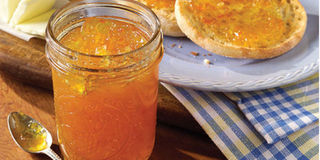Earn more from your fruits by making marmalade

There are two types of marmalades that can be prepared – jelly and thick. Jelly marmalade contains finely cut peels, whereas thick has almost everything, but the seeds.
As with other fruit jellies, a higher proportion of citrus fruits is required for jelly marmalade than for thick variety.
Although citrus fruits are rich in acid, the amount of fruit used in relation to the amount of marmalade obtained is small.
Marmalade can be spread on bread or toast, whisked into salad dressing or mixed with soy sauce to make a marinade that can be used on meats.
One way of extending the shelf-life of fruits is by preserving them as sugar concentrates, which also provides a way of utilising those that are not good enough or are too ripe.
Preparing
Wash and scrub the fruit with a kitchen brush, if necessary, to remove all the dirt and soil particles. To ensure easy peeling, the fruit can be scalded in hot water for about two minutes.
“For jelly marmalades, fine shreds of the peel, without pith, are cut after the fruit is hand-peeled. For thick types, however, chunkier slices can be cut from the whole peel with the pith,” says Faith Ndungi a food scientist.
According to the food scientists, all cuts should be uniform in size to make the product attractive. The white pith should be cut thinly and tied together with the pips and any excess peel in a muslin bag, and then cooked with the rest of the fruit.
The fruit needs to be cooked to extract the pectin and soften the peel before sugar is added. The amount of water used for cooking depends on the method of cooking and the type of pan used.
“Generally, allow two litres of water for every one kilogramme of fruit if cooked in an open pan or one litre of water for every kilo of fruit if cooked in a pressure pan. Preliminary cooking takes longer, usually two to three hours, unless a pressure cooker is used,” she says.
At the end of cooking, the pulp should be soft enough to disintegrate when squeezed between the fingers.
After sugar is added and dissolved, boiling is continued for about 15 to 20 minutes or until the setting point is reached.
Testing the setting point
a) Flake test
Dip the stirring spoon in the boiling mixture, then raise it at least 30cm above the pot. Hold the spoon horizontally for a few seconds, and then turn it so that the marmalade runs off the side. If it falls in clear drops, it is done. If the flow is continuous, it should be cooked a little longer.
b) Cold plate test
Pour a small amount of marmalade on a cold plate or saucer. When quite cold, push it with the forefinger. The marmalade is ready if it forms wrinkles and a skin forms on it.
Adding the acid
Although citrus fruits are rich in acid, the amount of fruit used in relation to the amount of marmalade obtained is small. For this reason, some marmalade recipes (such as orange and jelly) require additional acid that can be provided by adding juice or citric acid.
The acid is added into the pan with the fruit pieces before boiling.
The marmalade should be skimmed to remove scum as soon as it is ready to avoid the scum clinging to the peel.
To prevent the peel from rising in storage jars, the marmalade should be allowed to cool in the pan until a skin forms on the surface. It is then stirred gently, poured into clean, warm glass jars, and covered.
Source: Daily Nation




